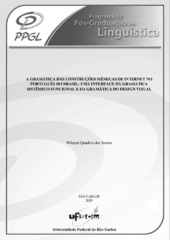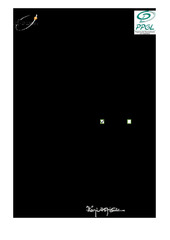| dc.contributor.author | Santos, Wilquer Quadros dos | |
| dc.date.accessioned | 2020-09-27T09:34:28Z | |
| dc.date.available | 2020-09-27T09:34:28Z | |
| dc.date.issued | 2020-08-25 | |
| dc.identifier.citation | SANTOS, Wilquer Quadros dos. A gramática das construções mêmicas de Internet no português do Brasil: uma interface da Gramática Sistêmico-Funcional e da Gramática do Design Visual. 2020. Tese (Doutorado em Linguística) – Universidade Federal de São Carlos, São Carlos, 2020. Disponível em: https://repositorio.ufscar.br/handle/ufscar/13292. | * |
| dc.identifier.uri | https://repositorio.ufscar.br/handle/ufscar/13292 | |
| dc.description.abstract | This work aims to investigate, analyze, map and systematize the linguistic and visual characteristics of Memes: a schematic structure of the digital genre known as Meme, particularly taken from the Internet in Brazilian Portuguese, in the interface of the Systemic-Functional Grammar and the Grammar of Visual Design. Since the advent of the Internet and especially of social sharing networks, Meme emerges as a multi-semiotic combination, a multimodal digital expression with a humorous and critical bias. Originally, the zoologist Richard Dawkins created the term meme in 1976 in the book The Selfish Gene. However, the meaning attributed to it on the Internet has distanced itself from the original meaning. This neologism (meme) was created from the root of the Greek word Mimema (imitation) and transposed to the sonority similar to the term gene, taking into consideration the fact that, for Dawkins, the meme is the gene of the culture. Dawkins conceives memes as behavioral replicators, transmission units and cultural imitation. For the author, memes are responsible for the propagation of facts, reproduction of thought and behavior (DAWKINS, 2017). Methodologically, this research focuses on the analysis and on the description of the verb-visual syntactic configuration of Internet Memes. Taking into consideration the survey of the memic occurrences between the years of 2014 and 2018 in social networks, sites, online repositories and classic models of this digital genre in the Brazilian Portuguese, a mapping of the lexical-grammatical and visual functions that can be typifiers of the genre under analysis is done, as well as the systematizing of the schematic structure of the genre from its linguistic and visual aspects, that is, from the textual completeness. In this paper, we analyze the multisemiotic aspect of the Meme from the internet, which has as its main theoretical contribution the authors Blackmore (1999, 2000), Cabral and Fuzer (2014), Dawkins (2017), Gouveia (2009), Halliday (1994, 2001, 2009), Kress and van Leeuwen (1996, 2006), Lima-Lopes (2012), Marcuschi (2001, 2009), Neves (1994, 2001, 2012), Recuero (2007). Finally, it is understood that Memes can typically be verbally composed of material processes, declarative sentences and topical themes. In the visual sphere, verbal narrative and symbolic conceptual processes increase, as well as a Demand type grammar, in the middle plane and from a frontal point of view. Although in a less regular way, the visual syntax is segmented, dividing the given and new information, predominating the color, font and collage as factors of salience. In addition, they can be composed of nominal groups, simple sentences or complex sentences, experiencing suppression and constructional changes. These gaps and variations are recoverable in the context of the situation and in the interface with the visual element. | eng |
| dc.description.sponsorship | Coordenação de Aperfeiçoamento de Pessoal de Nível Superior (CAPES) | por |
| dc.language.iso | por | por |
| dc.publisher | Universidade Federal de São Carlos | por |
| dc.rights | Attribution-NonCommercial-NoDerivs 3.0 Brazil | * |
| dc.rights.uri | http://creativecommons.org/licenses/by-nc-nd/3.0/br/ | * |
| dc.subject | Meme de internet. | por |
| dc.subject | Gramática Sistêmico-Funcional. | por |
| dc.subject | Gramática do Design Visual | por |
| dc.subject | Gêneros digitais | por |
| dc.subject | Multimodalidade | por |
| dc.subject | Meme from the internet | eng |
| dc.subject | Systemic-Functional Grammar | eng |
| dc.subject | Grammar of Visual Design | eng |
| dc.subject | Digital genre | eng |
| dc.subject | Multimodality | eng |
| dc.title | A gramática das construções mêmicas de Internet no português do Brasil: uma interface da Gramática Sistêmico-Funcional e da Gramática do Design Visual | por |
| dc.title.alternative | The grammar of Internet memic construction in Brazilian Portuguese: an interface between Systemic-Functional Grammar and Visual Design Gramma | eng |
| dc.type | Tese | por |
| dc.contributor.advisor1 | Hirata-Vale, Flávia Bezerra de Menezes | |
| dc.contributor.advisor1Lattes | http://lattes.cnpq.br/2797556968074056 | por |
| dc.description.resumo | Este trabalho objetiva investigar, mapear, analisar e descrever as características linguísticas e visuais tipificadoras, a saber, a construção gramatical do gênero digital Meme de internet no português do Brasil, na interface da Gramática Sistêmico-Funcional e da Gramática do Design Visual. Com o advento da Internet e, especialmente, das redes sociais, o Meme emerge como um amálgama de semioses, um gênero digital multimodal de tom humorístico e crítico. Contudo, originalmente, o termo meme, distanciando-se do sentido que lhe é atribuído hodiernamente na Internet, foi cunhado pelo zoólogo Richard Dawkins, em 1976, no livro O Gene Egoísta. Esse neologismo (meme) foi criado a partir da raiz da palavra grega Mimema (imitação) e transposto à sonoridade similar à do termo gene, uma vez que, para Dawkins, o meme é o gene da cultura, uma unidade de transmissão e de imitação cultural (DAWKINS, 2017). A partir do levantamento das ocorrências mêmicas nas redes sociais, nos sites e nos repositórios online, a pesquisa, metodologicamente, focalizou a análise e a descrição da construção gramatical verbo-visual dos Memes de Internet, mapeando as funções léxico-gramaticais e visuais que possam ser tipificadoras do gênero em análise. Levando-se em conta o aspecto multissemiótico do Meme de internet, este estudo tem como aporte teórico, em linhas gerais, Blackmore (1999, 2000), Cabral e Fuzer (2014), Dawkins (2017), Gouveia (2009), Halliday (1985, 1994), Halliday e Matthiessen (2004, 2014), Heylighen (1994, 1997, 2009), Kress e van Leeuwen (1996, 2006), Lima-Lopes (2012), Marcuschi (2001, 2009), Neves (1994, 2001, 2012) e Recuero (2007). Por fim, entende-se que os Memes tipicamente podem ser compostos, no âmbito verbal, de processos materiais, orações declarativas e tema tópico. Na esfera visual, avultam os processos narrativos verbais e os conceituais simbólicos, assim como uma gramática do tipo Demanda, em plano médio e com ponto de vista frontal. Embora de maneira menos regular, a sintaxe visual é segmentada, dividindo a informação dada e a nova, predominando a cor, fonte e a colagem como fatores de saliência. Além disso, podem ser compostos de grupos nominais, de orações simples ou de complexos oracionais, sofrendo supressões e mudanças construcionais, sendo essas lacunas e variações recuperáveis no contexto de situação e na interface com o elemento visual. | por |
| dc.publisher.initials | UFSCar | por |
| dc.publisher.program | Programa de Pós-Graduação em Linguística - PPGL | por |
| dc.subject.cnpq | LINGUISTICA, LETRAS E ARTES::LINGUISTICA::TEORIA E ANALISE LINGUISTICA | por |
| dc.description.sponsorshipId | CAPES: Código de Financiamento 001 | por |
| dc.publisher.address | Câmpus São Carlos | por |
| dc.contributor.authorlattes | http://lattes.cnpq.br/0966187215435807 | por |


